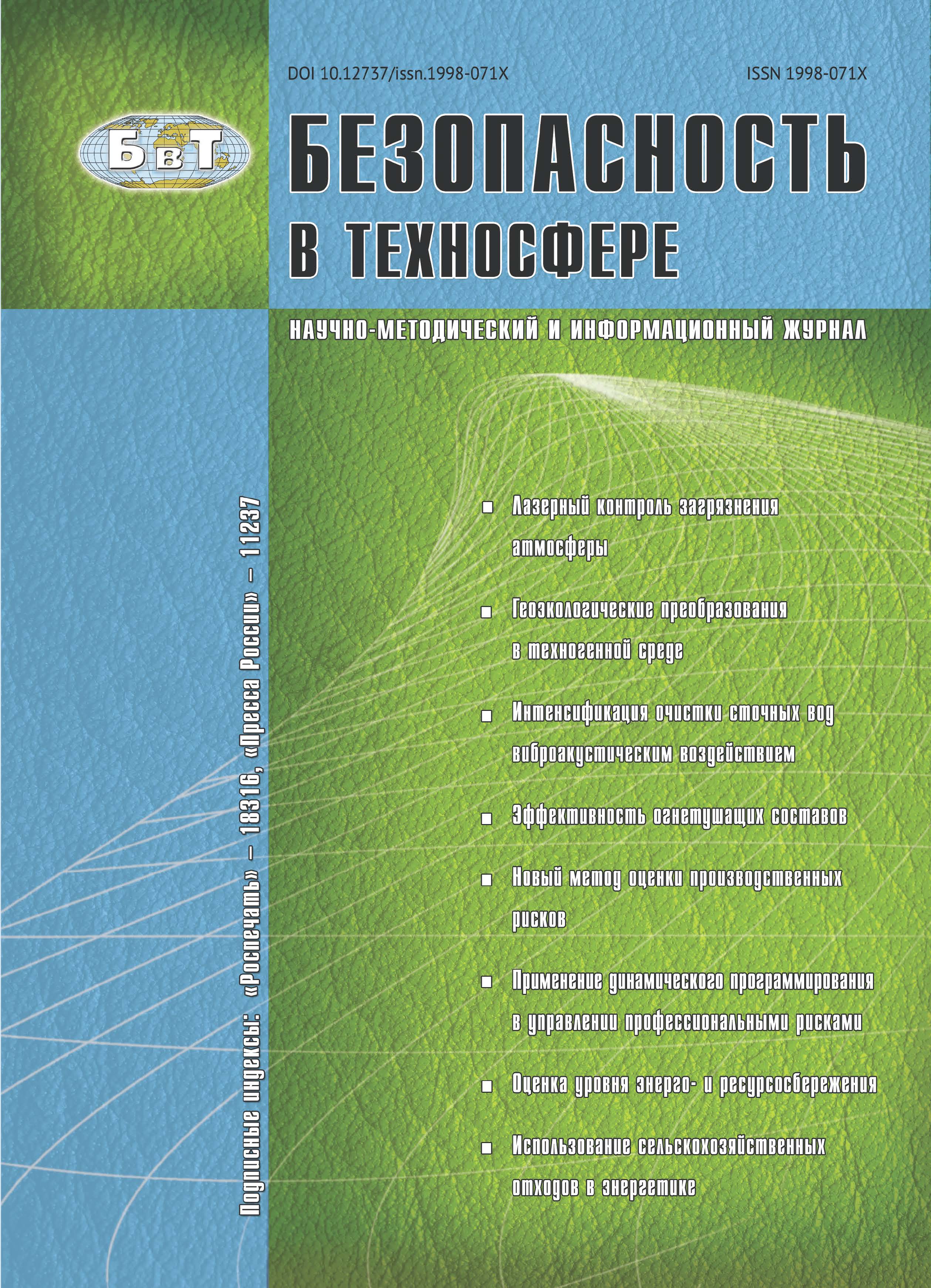Comparative assessment of the average failure rate of the basic elements of pneumatic systems has been presented. Structure oftechnical systems failures to ensure safety of technological processes involving protective gas has been described. Decisive influence of operating conditionsand parameters of protective gas industrial purity on safety of technological processes has been revealed.Regardless of the complexitylevel of the system, the occurrence of many kinds of failure is caused by negative impact of large-scale and subjective factors associated with the absence of objective monitoring of protective gasindustrial purity. Design, construction and operation of technical systems ensuring safety of technological processes involving protective gas is often based onprinciples typical for technological processes, not taking into account the specific features of operation of objects of protection.
safety systems for pressurized protective gas, industrial purity of protective gas, adsorption air-drying.
1. Введение
В последние десятилетия ущерб от техногенных аварий становится сопоставимым с ущербом от природных катаклизмов и региональных конфликтов. Решить проблемы техносферной безопасности существующими методами зачастую удается, поэтому при разработке и совершенствовании современных технических систем «человек–машина–среда», обеспечивающих надежность и безопасность технологических процессов (ТС БТП), наряду с традиционными подходами должны применяться новые подходы, в частности учитывающие влияние масштабных и субъективных факторов [1].
Традиционные подходы, позволяющие прогнозировать и предотвращать отказы и аварии в ТС БТП, развиваясь на основе стандартных инженерных решений, остаются эффективным инструментом при разработке, совершенствовании и анализе хорошо структурированных технических систем, построенных на принципах автоматического управления (САУ), где функции человека сводятся к разработке, изготовлению, обслуживанию, отладке и контролю работы системы. Важно, что само управление здесь осуществляется без участия человека, на базе теории автоматического управления и основных функций САУ, таких как автоматический контроль и измерение, автоматическая сигнализация, автоматическая защита, автоматические пуск и остановка различного оборудования системы, автоматическое регулирование и поддержание заданных режимов ее работы и т.д.
Однако на верхнем уровне сложности современных ТС БТП, созданных на принципах автоматизированного управления (АСУ), в которых САУ обычно выступают лишь в качестве подсистем АСУ, а наличие человека в контуре управления играет важную роль и является принципиальным условием, применение комплексных подходов, основанных на вероятностно-статистических оценках, учитывающих влияние масштабных и субъективных факторов, дает определенные преимущества, особенно в области обеспечения пожарной и промышленной безопасности.
1. Pereezdchikov I.V. Razrabotka osnov analiza opasnosti promyshlennyh sistem «chelovek-mashina-sreda» na baze chetkih i nechetkih mnozhestv. Dokt. Diss. [Development of bases hazard analysis of industrial systems "man-machineenvironment" on the basis of clear and fuzzy sets. Doct. Diss.]. Moscow, 2005.
2. State Standard IEC 60079-2-2011. Explosive atmospheres - Part 2: Equipment protection by pressurized enclosure «p». Moscow, Standartinform Publ., 2014. 46 p. (in Russian)
3. Karvovskij G.A. Jelektrooborudovanie i okruzhajushhaja sreda [Electrical equipment and environment]. Moscow, Jenergoatomizdat Publ., 1984.
4. Guidance Document 45.070-99. Compressor-signal for local networks. General technical requirements. St. Petersburg, LONIIS Publ., 1999. (in Russian)
5. Instruction of content of cable lines of urban telephone networks under excessive air pressure. Moscow, Radio i svyaz´ Publ., 1982. (in Russian)
6. Instruction of the construction of linear structures of local networks. V. 2. Moscow, SSKTB-TOMASS Publ., 1995. (in Russian)
7. Operating Manual of outside plant local networks. Moscow, UJeS Goskomsvjazi Rossii Publ., 1998. (in Russian)
8. Baron D.A., Grodnev I.I., Evdokimov V.N. Stroitel´stvo kabel´nyh sooruzhenij svjazi: Spravochnik [Construction of cable communication structures]. Moscow, Radio i svyaz´ Publ., 1988.
9. Jack P. It’s raining in our cables. Outside Plant, 1998, no. June, pp. 44-47.
10. Belov S.V. Bezopasnost´ zhiznedejatel´nosti i zashhita okruzhajushhej sredy (tehnosfernaja bezopasnost´) [Life safety and environmental protection (technosphere safety)]. Moscow, Jurajt Publ., 2011.
11. Syrytsyn T.A. Nadezhnost´ gidro- i pnevmoprivoda [Reliability of hydraulic and pneumatic actuator]. Moscow, Mashinostroenie Publ., 1981.
12. Kel´tsev N. V. Osnovy adsorbtsionnoy tekhniki [Fundamentals of adsorption technology]. Moscow, Himija Publ., 1984.
13. Glizmanenko D.L. Poluchenie kisloroda [Preparation of oxygen]. Moscow, Himija Publ., 1972.
14. Pavlikhin G.P., L´vov V.A, Burlakov A.V. Peculiarities of gas protection parameters in object under overpressure. Vestnik MGTU im. N.Je. Baumana [Journal of Bauman Moscow State Technical University], 2004, I. 3, pp. 115-123. (in Russian)
15. L´vov V.A., Nikol´skij V.F. Applied climatology telecommunication cable lines. Vestnik svjazi [Journal of communication], 2004, I. 4, pp. 167-172. (in Russian)
16. L´vov V.A., Nikol´skij V.F. The functionality of the moisture indicator. Vestnik svjazi [Journal of communication], 2003, I. 11, pp. 62-67. (in Russian)
17. L´vov V.A., Nikol´skij V.F. Features of the control parameters of the air fed into the cable line. Vestnik svjazi [Journal of communication], 2002, I. 11, pp. 98-101. (in Russian)
18. Pavlikhin G.P., L´vov V.A., Kalugina O.G. Evaluation of silica gel water capacity for pneumatic systems’ safe operation assurance. Bezopasnost´ v tekhnosfere [Safety in technosphere], 2014, I. 6, pp. 43-52. (in Russian) DOI:https://doi.org/10.12737/6635






